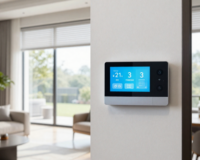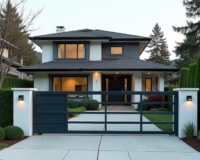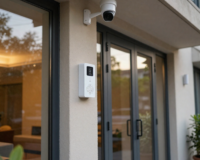Smart Window Control Systems: Benefits, Automation & Energy Efficiency
Introduction
In modern smart homes and buildings, comfort, sustainability, and convenience go hand in hand. Among the many innovations reshaping automation, Smart Window Control Systems stand out as one of the most practical and energy-efficient solutions available today.
These intelligent systems allow users to open, close, and manage ventilation or shading with a simple command — through a wall switch, remote control, or even a smartphone app. When connected with smart home ecosystems, they can automatically respond to indoor climate, outdoor temperature, or occupancy patterns, making spaces more comfortable and energy-conscious.
According to the Australian Government’s energy efficiency guidelines, smart ventilation and window automation systems play a key role in reducing household energy use and improving indoor comfort in all climate zones.

What Are Smart Window Control Systems?
A smart window control system automates the operation of windows, skylights, or vents using actuators, sensors, and smart controllers. These systems replace manual window operation with motorised components, providing automatic control for ventilation, smoke evacuation, and energy management.
Whether used in homes to improve air quality or in commercial buildings to meet sustainability targets, smart window systems make life easier while reducing energy costs.
For instance, the Yale Aeron Wireless Actuator offers a seamless wireless solution for window automation. Its sleek design integrates easily into modern interiors, providing precise control without complicated wiring.
Learn more about Yale’s range of connected home products on the official Yale Smart Home site.
Key Benefits of Smart Window Control Systems
1. Enhanced Energy Efficiency
Smart windows contribute significantly to energy savings by automating ventilation based on indoor conditions.
When paired with energy-efficient actuators like the FAKRO Z-Wave Chain Winder (12 V), these systems help optimise natural airflow and daylight usage.
According to the Smart Energy Council, automated ventilation and natural cooling can reduce HVAC energy costs by up to 30 percent.
2. Improved Indoor Air Quality
Inadequate ventilation is one of the most common issues in modern insulated homes. Smart window systems ensure fresh air circulates regularly without manual intervention.
Many modern actuators, like those from FAKRO’s automation range, now integrate advanced sensors for better environmental control.
3. Convenience and Smart Control
Forget about climbing to reach skylights or hard-to-access windows. With automation, everything is within reach of your smartphone or home control system.
Systems like Yale Aeron can be controlled wirelessly, while Z-Wave devices such as FAKRO Chain Winders integrate easily with popular smart hubs, allowing homeowners to manage windows along with blinds, lights, and heating from a single app.
4. Safety and Security
Automated windows enhance security by automatically closing when you leave the house or when rain is detected.
As FAKRO’s global guide to smart window safety highlights, automated actuators play a vital role in maintaining both safety and energy balance.
Popular Smart Window Actuators and Systems
1. Yale Aeron Wireless Actuator
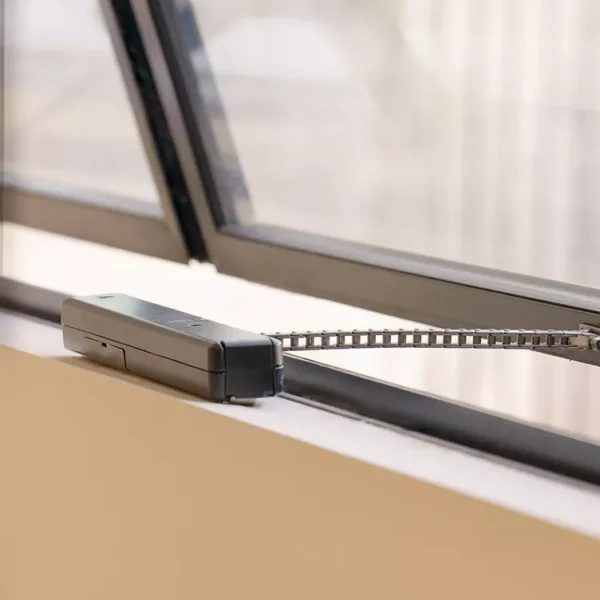
The Yale Aeron provides a reliable, wireless solution for automating window operations.
-
Wireless control eliminates complex wiring.
-
Compact design fits easily into modern architecture.
-
Low-power operation ensures long-term reliability.
For more details, visit Yale’s official home automation page.
2. FAKRO Z-Wave Chain Winder (12 V)
FAKRO Z-Wave Chain Winder 12 V

The FAKRO Z-Wave Chain Winder is designed for precision control and seamless integration into smart home systems.
-
Z-Wave compatibility ensures smooth communication with existing ecosystems.
-
Quiet motor operation makes it ideal for living spaces and offices.
-
Adjustable chain length suits various window sizes.
-
Smart sensors enable responsive ventilation.
Learn how Z-Wave integration supports energy-efficient ventilation via FAKRO’s Automation Solutions.
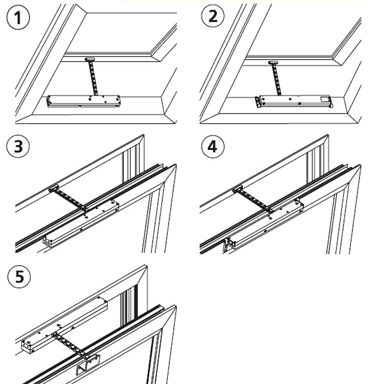
Integration with Smart Home Systems
Smart window control systems are not standalone — they’re part of a connected home. Integration with Z-Wave, KNX, or Wi-Fi-based platforms allows synchronised control alongside lighting, blinds, and security devices.
In Australia, standards set by the Smart Energy Council promote smarter energy management and sustainable automation technologies.
How Smart Windows Contribute to Building Efficiency
Smart window control systems do far more than just reduce energy consumption — they redefine how homes and businesses manage airflow, comfort, and light.
When windows are integrated with smart sensors and automation logic, the system can make micro-adjustmentsthroughout the day — opening slightly to relieve heat buildup, closing during strong winds or rain, and syncing with temperature sensors to balance indoor climate naturally.
This active control helps prevent overuse of HVAC systems, which are often responsible for more than 40% of total building energy use. Instead of letting air conditioners fight against trapped heat or poor airflow, automated windows allow the building itself to breathe intelligently.
In commercial projects, networked window actuators can link to central building management systems (BMS), providing real-time data for maintenance teams. For homes, these systems bring comfort automation to a new level — automatically coordinating with smart blinds, exhaust fans, and climate systems to maintain optimal air quality and temperature all year round.
The result is a building that isn’t just energy efficient — it’s responsive, self-regulating, and future-ready.
Choosing the Right System
When planning a smart window solution, consider:
-
Window type — awning, casement, or skylight.
-
Power options — low-voltage (12 V) or mains (230 V).
-
Communication protocol — Z-Wave, KNX, Zigbee, or Wi-Fi.
-
Integration — standalone control or full smart-home ecosystem.
Consulting an automation specialist like Digital Home Systems ensures your setup is professionally designed, safe, and future-ready.
Conclusion
Smart window control systems are no longer a luxury — they’re a practical investment for enhancing comfort, reducing energy costs, and embracing sustainable living.
By integrating actuators such as the Yale Aeron Wireless Actuator and the FAKRO Z-Wave Chain Winder 12 V, you can transform traditional windows into intelligent assets that work in harmony with your environment.
Smart automation not only delivers savings but also supports a greener lifestyle — aligned with insights from the U.S. Department of Energy and the Green Building Council of Australia.



